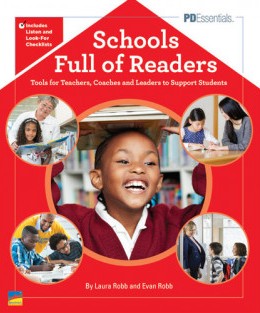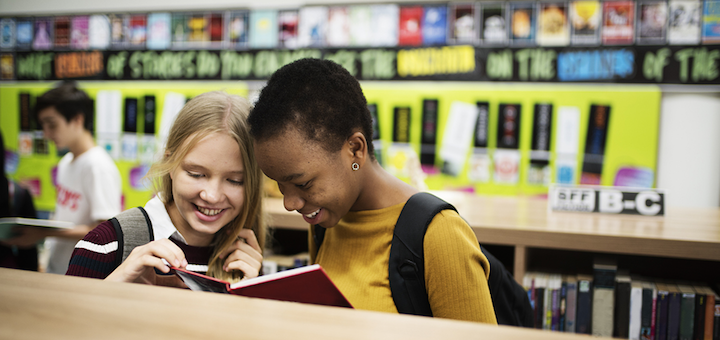How to Fill Our Schools with Eager Readers
By Laura Robb and Evan Robb
 Seventh grader Justin recently moved to Virginia. The first day in his new middle school was on October 3. In his old school in the midwest, Justin only read school assignments. There wasn’t a classroom library, and everyone in his ELA class read the same book.
Seventh grader Justin recently moved to Virginia. The first day in his new middle school was on October 3. In his old school in the midwest, Justin only read school assignments. There wasn’t a classroom library, and everyone in his ELA class read the same book.
They did worksheets and computer reading and quizzes for grades. His parents didn’t push Justin to read at home as he made B’s in core subjects. He could read, but that wasn’t the point. Among the friends Justin hung out with, not one read books for enjoyment.

Before the school day starts, the media center is a gathering place for students who enjoyed reading and discussing books. It has a green screen, and the librarian videos the students talking about books and small groups presenting readers’ theater.
The principal read aloud to Justin’s class twice in the first month Justin was at the school! His ELA teacher confers with Justin about his reading. Students carry free reading books to classes just in case there is time to read.
Now, every day, Justin reads books he selects from the classroom library. He’s discovered books he can’t put down and carries them in his backpack from class to class, hoping there will be time to read.
When Books and Reading Take Center Stage
What has transformed Justin into a student who’s beginning to enjoy reading?
In Justin’s new school the principal, teachers, librarian, and students value reading, and Justin has observed students reading in all of his classes. Most likely, a desire to be accepted by his new peers and please his new teachers nudged Justin to start reading. Checking out books from his classroom library – books that interested Justin – increased his desire to read even more.
Moreover, choice empowers students to personalize their reading experiences, and can develop students’ literary tastes as they read different genres and authors. Listening to peers discuss favorite books during class has broadened Justin’s knowledge of great reads. He enthusiastically participated in a small group discussion of Ghost by Jason Reynolds (Atheneum, 2017), a step he would not have taken in his old school.

Evan and Laura believe that before plunging into changing curriculum, training teachers, and educating parents, it’s important for a school’s staff to know why creating a culture of reading can affect students’ reading beliefs and habits.
To explore this question, Evan recommends that the principal form a team that includes teachers, the media specialist, and the principal who meet and explore the benefits of a culture of reading. As your team discusses the ideas, you’ll adjust some as well as add new ones. It’s important to understand the benefits, as these create the firm foundation needed to develop a list of what-do-we-need-to-do.
The WHY Drives a Culture of Reading
Evan and Laura have identified two areas that explain the ‘why’ behind a culture of reading: (1) how reading benefits students’ language development and learning, and (2) how it affects students’ personal growth.
Reading Improves Language Development for all learners when they have access to books relevant to their lives – books they can read throughout the school day. As students’ reading volume increases they develop:
• stamina to concentrate on reading for at least 30 minutes;
• critical thinking and problem solving skills;
• a broad knowledge base, vocabulary, the ability to read long texts and have meaningful discussions; and
• a knowledge of text structure, style, word choice, and voice that can transfer to their writing.
Reading Cultivates Personal Development by fostering self-confidence as learners see themselves in books and can discover who they are as people and readers. Reading offers:
• enjoyment and entertainment and develops students’ imagination as they visualize events and step into the shoes of characters and people to think and feel like they do;
• opportunities for learners to read about the past, present, and future and expand their knowledge base while developing empathy and compassion for others; and
• students repeated reflections on reading that can inspire, inform, and develop a personal reading life and can sustain them throughout their lives.
Once your ‘why’ is clear, the time is ripe for determining where your school is with creating a culture of reading. Next, develop an actionable plan and a reasonable timeline for implementation. As you collaborate, it’s crucial to involve teachers, administrators and staff. The goal is for most staff to buy into teaming up to create a culture of reading in their school, gather information about topics such as class libraries, student-centered learning, and volume in reading, and then share with the team.
Ten Ways to Foster a Culture of Reading
“It Takes a Lot of Slow to Grow.” These wise words written by the poet Eve Merriam can guide your reading initiative. Consistent small steps forward can result in progress and provide the time for reflection and adjusting the roadblocks that will inevitably occur.
Mull over and discuss these ten suggestions for creating a culture of reading in your school. Be selective and start with several suggestions that your team believes are the best ideas to launch your school’s reading initiative.
1. Fund class and school libraries. We know many initiatives compete for a place in a school’s budget. However, if creating a culture of reading is a priority, funding should be ongoing. Coaches and teachers can also apply for grants.
2. Become a role model. Conversations the principal and other administrators have with teachers, students, the school librarian, and parents should promote the school’s commitment to creating a culture of reading.
3. Share the research at team, department, and full faculty meetings. You might start with leadership team members suggesting articles and videos, and then
4. Extend the invitation to all teachers. The more background knowledge on topics like independent and instructional reading and a student-centered approach teachers have, the faster they’ll invest in building a school filled with readers.
5. Read aloud to ELA classes a favorite book from your childhood. Encourage other staff to read aloud to students. Elementary school administrators and teachers can create read aloud videos and post these on the school’s websites for families to use.
6. Discuss reading at team, department, and faculty meetings. We suggest the principal initiate this discussion, but then invite members of his leadership team and teachers to share reading snapshots, successes, and their personal feelings about reading.
7. Drop into classes during independent reading. Catch students’ enjoying reading and celebrate with positive feedback.
8. Feature short book talks and reviews. Morning announcements are a great time for the principal, students, or teachers to pitch a favorite book. You can also include student book reviews in a monthly e-newsletter.
9. Ask teachers to post what they’re reading on their classroom door and update the list each time they complete a book. Extend this invitation to administrators and staff, reserve a bulletin board in the library to post books, and show students how much the adults at school value reading.
10. Commend exemplary reading teachers in an email or written note and always use specific praise. Taking the time to do this shows how much you appreciate what they do.
Some Closing Thoughts
Laura and Evan invite you to make a commitment to developing a school like the one that transformed Justin into a reader. When students choose to read widely at school and at home, they become problem solvers who can analyze texts, think critically and develop the reading expertise and skill needed to become productive community and global citizens.
Developing a culture of reading, like any change initiative, takes commitment, leadership, collaboration, and communication as well as consistency while developing a common set of beliefs about reading.

The mother/son team’s latest book is Schools Full of Readers from Benchmark Education. Connect with Evan on Twitter @ERobbPrincipal. Learn more at Evan Robb.org. Visit Laura at her website or Twitter.




































